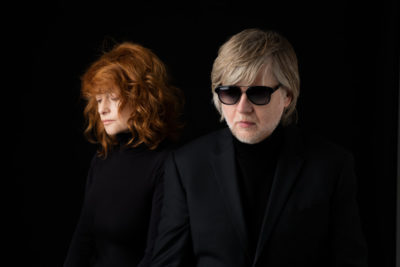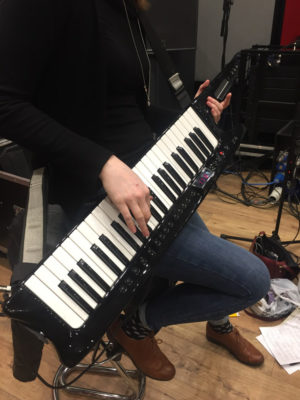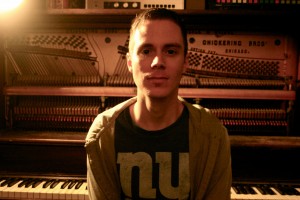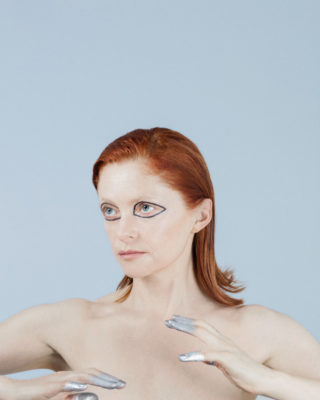Goldfrapp: Studio and Synth Secrets Unwrapped with “Silver Eye”
Goldfrapp. If ever there was an onomatopoeia of an artist’s name, that’s the one.
The English vocal and synth duo of Alison Goldfrapp and Will Gregory routinely give their fans something precious and rare when they deliver an album, a sonic gift to be unwrapped by the ears. And Goldfrapp keeps on giving, with the release of their seventh studio album Silver Eye.
A deeply enveloping and richly satisfying record, Silver Eye is everything listeners love these synthpop practitioners for, taken to the next level. Across the 10 tracks there is more imagination, more journey, more evil, more beauty, more glam, more adventure – and something sonically awesome is almost always in play. It’s Alison’s beautifully imaginative vocals from another planet , Gregory’s aggressive yet spacious arrangements, delicious dance beats, converging for a sound that is oft-imitated, but nailed precisely by no one else.
An album replete with optical imagery, Goldfrapp clearly had a vision when they were working in the studio on Silver Eye. Or did they? As it turns out, despite their tight partnership, Alison and Will are not afraid to enlist outside ears into their writing and recording process. The duo left London for 10 days in Dallas with GRAMMY-winning producer John Congleton (St. Vincent, John Grant, Wild Beasts). Back at home was more work with electronic composer Bobby Krlic, also known as The Haxan Cloak. Brian Eno’s collaborator Leo Abrahams guitar textures added to the tracks “Faux Suede Drifter” and “Beast That Never Was.” Mixer David Wrench merged the stems, and Mute Records founder Daniel Miller drilled down into multiple takes to find the perfect one, for tracks like “Everything Is Never Enough.”
The result is massive sounds that are also hugely addicting, building on an accomplished discography that includes Felt Mountain (2000), the megahit Supernature (2005), and the lushly transporting Seventh Tree (2008). Every song on Silver Eye will leave you happily gasping for air, with ice cold disco, precision experimentation, and cryrstalline rhythms. “Systemagic” is a blast into another galaxy, one where Goldfrapp keeps beautifully ticking time. “Be the One” is Bowiesque. There’s the cold Clockwork Orange of “Faux Suede Drifter,” and the chance to get lost in the “Zodiac Black” primordial swirl.
The album’s spiritual core, however, can be found in the song “Become the One,” where the lyric “Become the one you know you are” counsels to merge with your identity. It’s safe to say that Goldfrapp has done exactly that themselves with Silver Eye as they settle excitedly into their own skin.
Will Gregory spoke to SonicScoop from London, positively giddy – in a most English way, of course – about the record’s impending release, accidentally crafting big beats, studio synth insights, working with John Congleton, picking your mixer, and the vivaciousness of vinyl.
Will, Silver Eye marks Goldfrapp’s first release since Tales of Us in 2013.
It’s exciting that it’s coming out. We were told that we really HAD to get it finished, because vinyl pressing plants are so few and far between now. You have to get it in the queue. I’m excited that vinyl’s got this renewed status, that everybody wants it — that process when it goes from the digital to the analog really is extraordinary. It makes it great!
How would you characterize the dimension the vinyl brings?
It’s just an added scintillation to the sound, both on the top and the bottom. Something about having to squeeze the soundwaves onto those little grooves, when it happens it packages up in the way you want to sound. It’s just because we’re used to the way records sound, and when you hear that you kid yourself that it sounds better just because it sounds like a record.
But I think it’s more than that, I think it’s something that just happens. When all those digital releases came out remastered for CD you thought, “Good, maybe I’ll get something better.” But it never was. Maybe the person who was transferring it back onto vinyl, though, that’s where something magic happened.
If you could go back and tell yourself something in the year 2000 when you were recording Felt Mountain, when it came to studio workflow and production techniques, what would it be? What do you know now that you wish you knew then?
(Laughs) I’ll tell you one of the things, this is terrible geek stuff: I had this belief that whenever numbers transfer down a wire, digital to another input, that would be a perfect copy. We were always transferring digitally, from computer to hard disk, and quite often we used those little phono cables.
Someone told me afterwards, “Oh no, you can’t do that because you lose a load of quality.” I said, “What, how can that happen? It’s just ones and zeroes right?” But apparently it doesn’t work like that. You have to use high-quality cables and outputs when you’re transferring. So there you go: Digital doesn’t mean there’s only one level of quality.
It’s a bit better today now, right? Everything sits in one place on your computer – one hard drive with oodles of storage. But you can’t just look at the screen and trust the numbers…because they might be lying.
Also, it’s still true that you can make a record in a room. It doesn’t have to be a professional studio. I guess we know that now better than we ever have. So many studios have closed, and that’s sad. When you’re recording acoustically, the room that you’re in does add a hell of a lot to what you’re doing. It’s a huge percentage of the sound – if there’s a problem with the room or if it’s dodgy, or if it’s a beautiful room, that makes a difference.
Something we did often on Felt Mountain is we recorded outdoors, so there’s no acoustical (room) interference. Those are the kind of things I would go back and tell myself: You begin to realize that where you are is important.
Are you still recording in the same room that you always have?
We moved around a lot. When we recorded Felt Mountain, we rented a bungalow over the winter because it was cheap. I think other albums were done like that, but I got really tired of moving from one bungalow to the other to make an album. So we bought something that was like a bungalow, so that we didn’t have to keep moving stuff around.
This time for Silver Eye we did some of it in London, because Alison lives there. We rented a little space in a little studio complex with three studios on the East End. This lovely guy runs it, and we rented it for a year. It was just a room that was acoustically well-treated so you weren’t going to get too much noise. That’s all you need, I think.
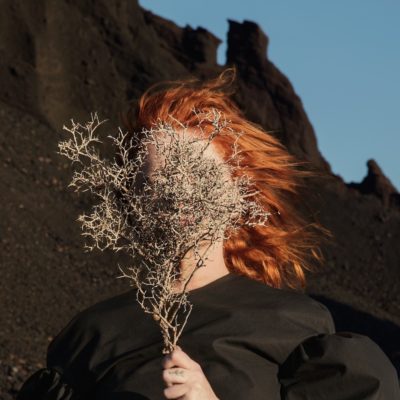
Goldfrapp found a room of their own for their seventh album “Silver Eye,” which came out March 31st on Mute.
On the other side, are there things you wish you could unlearn about recording techniques?
Things you get too fastidious about and you should probably just relax?? Now, one gets a bit lazy because there are these wonderful plugins that take all the noise out and one tends to trust them. I could just put a bit of noise reduction on them and just sort it out, but it always takes away a little bit of the sound. It’s worth being really careful, check all your wires, and isolate the buzz. Sometimes you’re thinking, “I should just get it down! I’m in the moment.” But then afterwards you can’t get that buzz away.
It’s impossible to unlearn things, isn’t it? That’s the trouble. Sometimes you’re working with a session musician and you say, “Can you just play like a beginner, so it sounds a little rank?” But I can never get a professional musician to do that, they can’t unlearn.
Beats Before Beatmakers
Are Goldfrapp “beatmakers”? The beat really seems integral to each song.
You have to make a decision about the groove, don’t you? You have to decide whether it’s a head-nodding thing, whether the music is that part of it, or whether it’s in another part.
I don’t think we work quite like beatmakers. I think the sophistication and expertise that I hear going on in rap, hip-hop, or R&B is so detailed and advanced and so fantastic, it’s a certain amount of expertise that I think we just don’t have. Most of the time, I don’t think we know what we’re doing with beats – we wish someone could come in and explain it and tell us how to do it, but we haven’t found anybody.
We do try to make the effort. With this album, for example, we had a few of our favorite tracks from other people and we play them for our drummer Sebastian Sternberg, and he played the version of these grooves that he thought we were aiming for in the drum track. Then we took those and turned them into loops we could use in any tempo. So if you had a kick–snare part that was just boom-bash, you can put a high hat part on to form these other things that might give it a little bit of life and swing.
I love Stevie Wonder’s drumming, because that’s all it is: something very simple, very functional, something not getting in the way of the song. On the negative side, you can go a little bit too far with all that, and there’s all these incredible sampled drum kits now that are recorded with the snare attack at 127 different velocities. You can go down the tube programming that sort of thing — and then you think “all it needed is boof-baff!”
Synths, Pedals, and Making the Bass
How do you approach getting the most out of your synths when you’re recording them?
I’ve got a collection now that’s out of control, so there’s more choice. Like in the song “Tiger Man,” there’s a lot of Moog Taurus pedal on that. That’s just a huge noise isn’t it? There’s no getting away from it.
And someone’s been making synths out of – remember the Commodore 64 chips? — there’s a SID chip, and there’s a synth now (by Jahtari) that gives you more access to the components of that sound. It’s definitely got this cheap, nasty digital side to it with a ton of character. Then you shove it into a posh EQ, and dial some low end back into it and you got the best of both worlds: a cheap and nasty palm computer game, but then ramped onto a huge EQ that makes it function like a massive bass line.
Analog synths won’t do that, because they sound too good, in a way. You can hear that SID chip synth on the bass line for (track #2 on Silver Eye) “Systemagic.”
There’s no rules there really, you’re just looking for character all the time and whatever makes that happen. Synth players now know that pedals are what you need on the end of your synths to make your array go further. You can take your most basic sound on a real journey with just a few pedals. That’s not a new thing, guitarists have known that before me.
What pedals are you using?
There’s a few that I always gravitate towards. For distortion there’s a Univox Super-Fuzz that is lovely, it fuzzes out, but it doesn’t take all the bottom end out.
And there’s a whole rig of industrial test equipment made by B&K, the Danish company. They made a ton of test oscillators and filters and mic preamps that were all designed for testing electronic equipment, but they’re also good for other things. It’s a test oscillator, but for some reason it’s got controls in the back so you can play from a keyboard and it’s just the most beautiful sine tone.
Tea Time in Texas
Which songs did you work on with John Congleton? What made him a good match for Goldfrapp at this juncture?
We went to Dallas! Yeah! We worked on all of them with them, some we used more of what he was doing, some we used less.
I think it was a confusing proposition for him. He tends to work with artists from the beginning and see it all the way through. We turned up with a bunch of songs that were already finished, but we thought that they needed to be brought up a little more. When you’ve got a song that’s been arranged, sometimes you need someone to say, “No, no, you need to do that bit twice.” It was great to have him as a third ear, for all sorts of things like that. When we were with him, he added a few bits on top, and used some of his grungy equipment.
I think that (Silver Eye track 10) “Ocean” he had an impact on – we definitely hadn’t gotten there with that one. And “Systemagic” he had some great arrangement ideas. He came at it with some fresh energy.
We liked John’s work with St. Vincent, and it was just nice to completely leave your comfort zone and get shoved around in a different environment. And (the electronic composer) Bobby Krlic, aka The Haxan Cloak, he had quite a significant role, I think. We worked remotely with him for a week.
At what point do you start thinking about the mix process? How did you select David Wrench for this album?
Well, I was on one of those producer judging days which I like doing, because you get to hear stuff that you haven’t heard. And there was an album I heard called Pendulum by FKA twigs, and also an album by a band called Jungle which I quite liked. I thought, “There’s somebody here with some big ears making this,” and Jungle were in the room. They said, “David Wrench is really great. He’s lovely.” So he came over and had a listen to what we were doing, three-quarters of the way there, and he was into it.
We had a good stint with him mixing. He has his own studio in some deep dark corner of North Wales in a garage. He won’t let anybody go there because it’s too small and it’s his own personal space. What we did is rented Nigel Godrich’s studio. We worked in there, then David would sort of take it back and check it to see what was like in his own space, and make some adjustments. He’s really got an amazingly good ear.
Partner Ships
Why is it so important to have a partner that inspires you, like Alison obviously does? What opportunities does this open up in the studio, creatively and technical?
I was sort of focusing on TV and film music, and I was feeling very much that this wasn’t addressing the real issue of making music, and I really wanted to do songwriting.
Wait, what I just said isn’t true! Doing music for visuals is really making music, when you’re usually having the story and the context imposed on you. Whereas when you’re writing a song you are the film writer, the screenwriter, the director, the actor.
But I can’t sing! I heard Alison sing, she had a lot of styles and ranges, and I thought maybe we had the same taste, and we sent each other music that confirmed it. We’re two people that don’t cover each other’s bases. She’s not technical, and she hasn’t had a musical education, much to her advantage – she’s a very instinctive person, and very immediate as well.
She immediately knows that something is cooking are not, so you don’t spend forever grinding yourself to a pulp on something that is never any good, or hasn’t got legs. We manage to do that together quite often, but certainly me without her, I would be doing that much more! Maybe we’re a bit like comedy writers: If the other person isn’t laughing you move on.
- David Weiss
Please note: When you buy products through links on this page, we may earn an affiliate commission.







